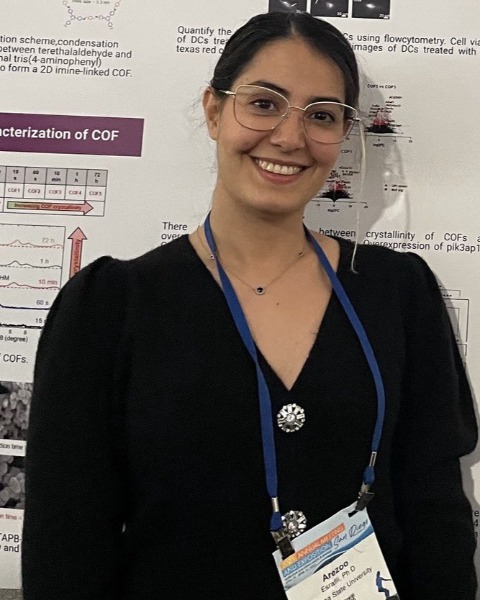Biomaterials
Role of the Degree of Crystallinity of Biomaterials on Modulation of Immune Responses by Immunotherapy
(B-62) Crystallinity of Covalent Organic Frameworks Controls Immune Responses
Friday, October 13, 2023
9:30 AM - 10:30 AM PDT
Location: Exhibit Hall - Row B - Poster # 62

Arezoo Esrafili, PhD
Graduate Stdent
Arizona State University
Phoenix, Arizona, United States
Presenting Author(s)
Introduction:: Bioactive biomaterials can be used as vaccine adjuvants, however how the degree of crystallinity of these biomaterial-based vaccines modulate immune system is poorly understood. Herein we demonstrate that adjuvant-like behaviour of covalent organic framework (COF) is dependent on its crystallinity, which then controls the anti-tumour immunity in mice melanoma model. It was found that in bone marrow derived dendritic cells there is an inverse relation between the crystallinity of COFs and activation (CD86+ in CD11c+) and antigen-presentation (H-2kb+ in CD11c+). Furthermore, it was determined that COFs with lowest crystallinity were able to prevent B16F10 that expressed chicken ovalbumin (OVA) and YUMM1.1 tumour growth in mice as compared to COF with highest crystallinity. Notably, the lowest crystallinity of COF with OVA induced pro-inflammatory responses (Tbet+ in CD45+ CD4+ and RoRγt+ in CD45+ CD4+) in B16F10-OVA tumour compared to no treatment and the highest crystallinity of COF. Moreover, lowest crystallinity of COF with OVA vaccine formulation increased tumour associated antigen specific T cells (Tbet+ OVAtet+ in CD45+ CD8+) in tumour cells. These results demonstrate that crystallinity of biomaterials is an important factor to consider when designing and generating anti-tumour immune responses.
Materials and Methods::
Results, Conclusions, and Discussions::
Our results demonstrate that the crystallinity of biomaterials is an important factor to consider when designing anti-tumour immune responses. Taking advantage of the tuneable crystallinity of COF leads to the activation of dendritic cells in vitro and generates immune responses and boosts OVA-specific immune responses in mice bearing melanoma in vivo. Our current research is focused on analyzing RNA-seq data to identify gene dysregulation in DCs treated with COFs and to uncover the underlying reasons why the lowest crystallinity of COF (COF1)-treated DCs generate a more robust immune response than those treated with the highest crystallinity of COF (COF5).
Acknowledgements (Optional): :
References (Optional): :
Materials and Methods::
- All variable crystallinity of imine-linked COF were synthesized through condensation of terephthaldehyde (PDA) and 1,3,5-tris(4-aminophenyl) benzene (TAPB) at 70° C. TAPB and PDA monomers lead to imine-linked 2D sheets. To form the crystal structure of COF, first TAPB and PDA condense to an amorphous network within 15 seconds the sheets undergo π-π stacking. 1,4-dioxane and mesitylene (4:1 v/v) as solvents and acetic acid as a catalyst were used. 15 seconds dried by vacuum, 60 seconds dried by supercritical CO2 (scCO2),10 mins, 1 h, and 3 days are the reaction times of the formation of an amorphous(COF1) to the highest crystallinity(COF5), respectively.
- B16F10 OVA expressing cells in PBS was injected subcutaneously (Right side) into C57BL/6j at day 0. The vaccines are generated with COF and endotoxin-free OVA. 1 mg of COF1 (the lowest crystallinity) with 50 ug of endotoxin-free OVA (vaccine grad), 1 mg of COF3 (the medium crystallinity), and 1 mg of COF5 (the highest crystallinity) with the same amount of vaccine grade OVA were injected subcutaneously to the left side of mice at day 5. All mice were sacrificed and tumors and spleens and lymph nodes were collected 20 days after inducing the disease (in vivo).
- Dendritic cells treated with COF1, COF2, COF3, COF4, and COF5 at 0.05 mg/mL pre-mixed with OVA protein (10ug/ml) for 24 hours on 96 well-round bottom tissue culture-treated polystyrene plates to test the ability of different crystallinity of COFs as an adjuvant and OVA as an antigen model on modulation of DCs (in vitro).
Results, Conclusions, and Discussions::
COF 1 with OVA increases cross-presentation of 257-264 SIINFEKL OVA peptide in DC, with and without inflammation. DCs treated with COF1 with OVA had lower gMFI CD163+ in CD11c+ compared to other treatments, with and without inflammation. High expression of CD206+ in CD11c+ in the presence of COF1 with OVA compared to COF 5 with OVA, LPS, and soluble OVA. In the presence of LPS, DCs treated with COF1 with OVA expressed more CD86+, however, Without inflammation, COF5 with OVA was able to induce more activation of DCs, in vitro.- The COF 1 with OVA vaccine treatment resulted in a dramatically reduction in tumor growth compared to control and COF5 with OVA-treated mice.
- Mice treated with COF1 with OVA had significantly higher numbers of Th1, activated Th1, Th17, and activated Th17. A significantly lower number of Treg in mice treated with COF1 with OVA as compared to no treated mice. The number of Tc1 cells and activated Tc1 cells in mice treated with COF1 OVA has significantly increased compared to the group that received no treatment. No significant differences in the number of OVA-specific Tc17 and activated OVA-specific Tc17 between COF1 with OVA and no treatment group was observed, in vivo.
Our results demonstrate that the crystallinity of biomaterials is an important factor to consider when designing anti-tumour immune responses. Taking advantage of the tuneable crystallinity of COF leads to the activation of dendritic cells in vitro and generates immune responses and boosts OVA-specific immune responses in mice bearing melanoma in vivo. Our current research is focused on analyzing RNA-seq data to identify gene dysregulation in DCs treated with COFs and to uncover the underlying reasons why the lowest crystallinity of COF (COF1)-treated DCs generate a more robust immune response than those treated with the highest crystallinity of COF (COF5).
Acknowledgements (Optional): :
References (Optional): :
